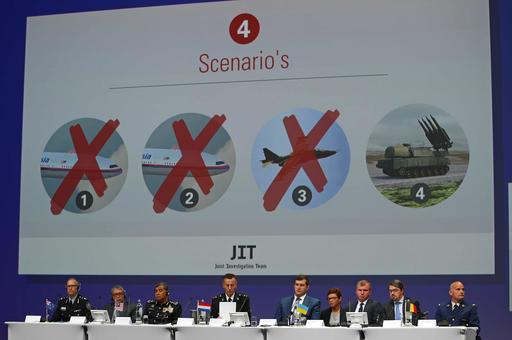Probe: Malaysian jet downed by missile launcher from Russia

The possible scenarios into the downing of Malaysia Airlines jetliner flight MH17 are put on display during a press conference by the Joint Investigation Team (JIT) on the preliminary results of the investigation in Nieuwegein, Netherlands, Wednesday, Sept. 28, 2016. The disaster claimed 298 lives. AP Photo/Peter Dejong
NIEUWEGEIN, Netherlands — Dutch-led criminal investigators said Wednesday they have solid evidence that a Malaysian jet was shot down in 2014 by a Buk missile that was moved into eastern Ukraine from Russia.
Wilbert Paulissen, head of the Central Crime Investigation department of the Dutch National Police, said communications intercepts showed that pro-Moscow rebels had called for deployment of the mobile surface-to-air weapon and reported its arrival on July 17, 2014, in rebel-controlled areas of eastern Ukraine.
The deadly surface-to-air weapon that blasted Malaysian Airlines Flight 17 out of the sky at 33,000 feet, killing all 298 people aboard, was launched that day from farmland in the rebel-held area of Pervomaiskiy, 5 kilometers (3 miles) from the eastern Ukrainian town of Snizhne, the investigation found.
Witnesses there reported an explosion and a whistling sound and a patch of field was set on fire.
From that and other evidence collected by the Joint Investigation Team, “it may be concluded MH17 was shot down by a 9M38 missile launched by a Buk, brought in from the territory of the Russian Federation, and that after launch was subsequently returned to the Russian Federation,” Paulissen told a news conference Wednesday in the Dutch town of Nieuwegein.
Article continues after this advertisementThe conclusions of the investigative unit — which includes police and prosecutors from the Netherlands, Ukraine, Belgium, Australia and Malaysia — were consistent with previous reporting by The Associated Press, which established soon after MH17’s destruction that a tracked Buk M-1 launcher with four SA-11 surface-to-air missiles had been sighted the same day in the rebel-controlled town of Snizhne near Pervomaiskiy.
Article continues after this advertisementA separate investigation by Dutch safety officials last year concluded that the Amsterdam-to-Kuala Lumpur flight was downed by a Buk missile fired from territory in Ukraine held by pro-Russian rebels.
Dutch police spokesman Thomas Aling said the joint investigation findings differ in that they are designed to be solid enough to be used as evidence in a criminal trial. Where and when a trial might take place is still to be determined, Aling said.
Russia has consistently denied allegations that pro-Moscow rebels in eastern Ukraine were responsible for downing the passenger plane.
On Monday, the Russian military said it has new radio-location data that showed the missile that downed the Boeing 777 did not originate from rebel-controlled territory, and said it would turn that data over to investigators.
Kremlin spokesman Dmitry Peskov reiterated that assertion on Wednesday ahead of the Dutch report.
“If there was a rocket, it could only have been launched from a different area,” he told reporters, referring to Russian radar data. “You can’t argue with it, it can’t be discussed.”
Ukrainian officials countered that the Dutch-led team’s findings prove Russia’s complicity in the tragedy.
“A new and very important element in today’s report is the information about the route by which the weapon came from Russia to Ukraine and was removed in the opposite direction through part of the Ukrainian-Russian border that was controlled only by Russia and their militants,” Ukraine’s Foreign Ministry said in a statement. “This again points to the direct involvement of the aggressor state in the downing of the aircraft.”
In the Joint Investigation Team, police and judicial officials have been working together to gather the best possible evidence for use in prosecution of the perpetrators.
They have faced extraordinary challenges. The crime scene in Ukraine’s eastern Donetsk oblast region where the plane was brought down on July 17, 2014, killing all aboard, was located in an active war zone. During the days following the downing, pro-Kremlin militants limited access to the crash site.
Eleven containers crammed with debris from the jetliner were ultimately brought to the Netherlands. A research team took soil samples in eastern Ukraine and established the location of cellphone towers and the layout of the local telephone network to verify intercepted phone calls from the militants.
Forensic samples were taken from passengers’ and crew members’ bodies and luggage, and satellite data and communications intercepts were scrutinized. The team also appealed for information from witnesses who may have seen the missile launch.
About two-thirds of the passengers aboard MH17 were Dutch nationals; the crew members were Malaysians. Malaysia proposed setting up an international tribunal to try those responsible for the plane’s destruction, but Russia vetoed a U.N. Security Council resolution in favor of a tribunal.